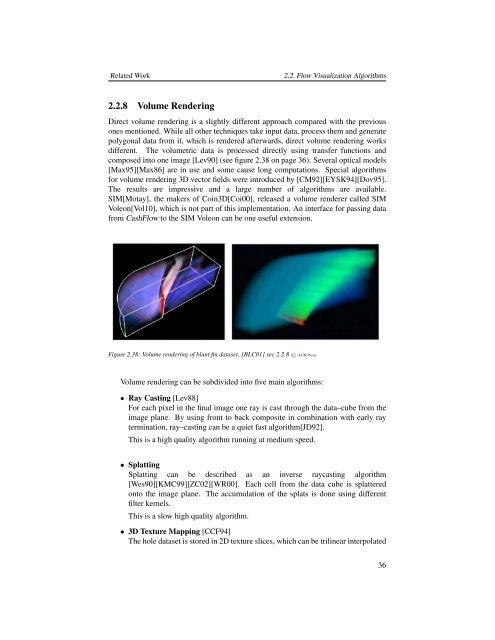CashFlow, A Visualization Framework for 3D Flow - Studierstube ...
CashFlow, A Visualization Framework for 3D Flow - Studierstube ...
CashFlow, A Visualization Framework for 3D Flow - Studierstube ...
- No tags were found...
Create successful ePaper yourself
Turn your PDF publications into a flip-book with our unique Google optimized e-Paper software.
Related Work2.2. <strong>Flow</strong> <strong>Visualization</strong> Algorithms2.2.8 Volume RenderingDirect volume rendering is a slightly different approach compared with the previousones mentioned. While all other techniques take input data, process them and generatepolygonal data from it, which is rendered afterwards, direct volume rendering worksdifferent. The volumetric data is processed directly using transfer functions andcomposed into one image [Lev90] (see figure 2.38 on page 36). Several optical models[Max95][Max86] are in use and some cause long computations. Special algorithms<strong>for</strong> volume rendering <strong>3D</strong> vector fields were introduced by [CM92][EYSK94][Dov95].The results are impressive and a large number of algorithms are available.SIM[Motay], the makers of Coin<strong>3D</strong>[Coi00], released a volume renderer called SIMVoleon[Vol10], which is not part of this implementation. An interface <strong>for</strong> passing datafrom <strong>Cash<strong>Flow</strong></strong> to the SIM Voleon can be one useful extension.Figure 2.38: Volume rendering of blunt fin dataset. [BLC01] sec 2.2.8 c○ ACM PressVolume rendering can be subdivided into five main algorithms:• Ray Casting [Lev88]For each pixel in the final image one ray is cast through the data–cube from theimage plane. By using front to back composite in combination with early raytermination, ray–casting can be a quiet fast algorithm[JD92].This is a high quality algorithm running at medium speed.• SplattingSplatting can be described as an inverse raycasting algorithm[Wes90][KMC99][ZC02][WR00]. Each cell from the data cube is splatteredonto the image plane. The accumulation of the splats is done using differentfilter kernels.This is a slow high quality algorithm.• <strong>3D</strong> Texture Mapping [CCF94]The hole dataset is stored in 2D texture slices, which can be trilinear interpolated36





